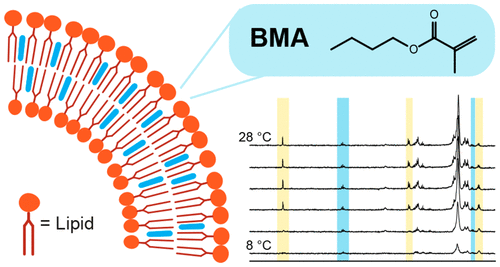Our official English website, www.x-mol.net, welcomes your feedback! (Note: you will need to create a separate account there.)
Membrane Stability in the Presence of Methacrylate Esters.
Langmuir ( IF 3.9 ) Pub Date : 2020-03-23 , DOI: 10.1021/acs.langmuir.9b03759 Vivien Yeh 1 , Alice Goode 1 , Graham Eastham 2 , Robert P Rambo 3 , Katsuaki Inoue 3 , James Doutch 4 , Boyan B Bonev 1
Langmuir ( IF 3.9 ) Pub Date : 2020-03-23 , DOI: 10.1021/acs.langmuir.9b03759 Vivien Yeh 1 , Alice Goode 1 , Graham Eastham 2 , Robert P Rambo 3 , Katsuaki Inoue 3 , James Doutch 4 , Boyan B Bonev 1
Affiliation

|
Bioproduction of poly(methyl methacrylate) is a fast growing global industry that is limited by cellular toxicity of monomeric methacrylate intermediates to the producer strains. Maintaining high methacrylate concentrations during biofermentation, required by economically viable technologies, challenges bacterial membrane stability and cellular viability. Studying the stability of model lipid membranes in the presence of methacrylates offers unique molecular insights into the mechanisms of methacrylate toxicity, as well as into the fundamental structural bases of membrane assembly. We investigate the structure and stability of model membranes in the presence of high levels of methacrylate esters using solid-state nuclear magnetic resonance (NMR) and small-angle X-ray scattering (SAXS). Wide-line 31P NMR spectroscopy shows that butyl methacrylate (BMA) can be incorporated into the lipid bilayer at concentrations as high as 75 mol % without significantly disrupting membrane integrity and that lipid acyl chain composition can influence membrane tolerance and ability to accommodate BMA. Using high resolution 13C magic angle spinning (MAS) NMR, we show that the presence of 75 mol % BMA lowers the lipid main transition temperature by over 12 degrees, which suggests that BMA intercalates between the lipid chains, causing uncoupling of collective lipid motions that are typically dominated by chain trans–gauche isomerization. Potential uncoupling of the bilayer leaflets to accommodate a separate BMA subphase was not supported by the SAXS experiments, which showed that membrane thickness remained unchanged even at 80% BMA. Reduced X-ray scattering contrast at the polar/apolar interface suggests BMA localization in that region between the lipid molecules.
中文翻译:

甲基丙烯酸酯存在下的膜稳定性。
聚(甲基丙烯酸甲酯)的生物生产是一个快速发展的全球工业,受到单体甲基丙烯酸酯中间体对生产菌株的细胞毒性的限制。经济上可行的技术要求在生物发酵过程中保持高甲基丙烯酸酯浓度,这会挑战细菌膜的稳定性和细胞活力。研究在甲基丙烯酸酯存在下模型脂质膜的稳定性,为甲基丙烯酸酯毒性机理以及膜组装的基本结构基础提供了独特的分子见解。我们使用固态核磁共振(NMR)和小角X射线散射(SAXS)研究了在高含量的甲基丙烯酸酯存在下模型膜的结构和稳定性。宽线31P NMR光谱表明,甲基丙烯酸丁酯(BMA)可以以高达75 mol%的浓度掺入脂质双层,而不会显着破坏膜的完整性,并且脂质酰基链组成会影响膜的耐受性和适应BMA的能力。使用高分辨率13 C幻角旋转(MAS)NMR,我们显示75 mol%BMA的存在将脂质主转变温度降低了12度以上,这表明BMA插在脂质链之间,导致集体脂质运动解偶联这通常是由链为主的反式-笨拙异构化。SAXS实验不支持双层小叶潜在的解偶联以容纳单独的BMA亚相,这表明即使80%BMA膜厚度也保持不变。极性/非极性界面的X射线散射对比度降低表明BMA定位在脂质分子之间的该区域中。
更新日期:2020-03-23
中文翻译:

甲基丙烯酸酯存在下的膜稳定性。
聚(甲基丙烯酸甲酯)的生物生产是一个快速发展的全球工业,受到单体甲基丙烯酸酯中间体对生产菌株的细胞毒性的限制。经济上可行的技术要求在生物发酵过程中保持高甲基丙烯酸酯浓度,这会挑战细菌膜的稳定性和细胞活力。研究在甲基丙烯酸酯存在下模型脂质膜的稳定性,为甲基丙烯酸酯毒性机理以及膜组装的基本结构基础提供了独特的分子见解。我们使用固态核磁共振(NMR)和小角X射线散射(SAXS)研究了在高含量的甲基丙烯酸酯存在下模型膜的结构和稳定性。宽线31P NMR光谱表明,甲基丙烯酸丁酯(BMA)可以以高达75 mol%的浓度掺入脂质双层,而不会显着破坏膜的完整性,并且脂质酰基链组成会影响膜的耐受性和适应BMA的能力。使用高分辨率13 C幻角旋转(MAS)NMR,我们显示75 mol%BMA的存在将脂质主转变温度降低了12度以上,这表明BMA插在脂质链之间,导致集体脂质运动解偶联这通常是由链为主的反式-笨拙异构化。SAXS实验不支持双层小叶潜在的解偶联以容纳单独的BMA亚相,这表明即使80%BMA膜厚度也保持不变。极性/非极性界面的X射线散射对比度降低表明BMA定位在脂质分子之间的该区域中。



























 京公网安备 11010802027423号
京公网安备 11010802027423号